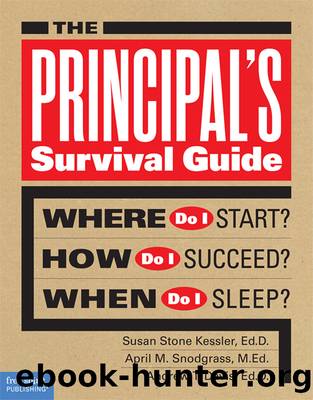The Principal's Survival Guide by Susan Stone Kessler

Author:Susan Stone Kessler
Language: eng
Format: epub
ISBN: 9781631980084
Publisher: Free Spirit Publishing
Published: 2015-03-31T00:00:00+00:00
Teachers writing about their school and students on blogs, Facebook, Twitter, or other social media is now a common practice, and schools can be held accountable for these public comments. Also, employees can find themselves in trouble for inappropriate comments. What used to be water cooler orâin the education worldâcopy machine talk, is now exposed to the wider world, and that comes with ramifications.
Tell teachers: Unless you are comfortable with it being on the front page of the local newspaper or being read by your principal, donât put it on social media. Once something is out there, it is out there, and it is not going away. Depending on privacy settings, it can be seen by anyone at any time.
If you see or learn of something inappropriate on an employeeâs social media that is specifically about the school, address it right away because it can affect the schoolâs reputation. Request that the employee remove it immediately, but make this request with a witness present. It is possible that the employee may say that you are trying to infringe on her First Amendment rights, so following the districtâs policy, if it exists, is important. If there is no policy, then you will want to talk with your supervisors and get their thoughts on the matter before addressing the situation to ensure that the district will support your plan of action. Remind teachers, too, that principals can and will take what they write in social media into consideration when making decisions about their continued employment or continuation in a particular role in the school.
Clothing
Young teachers sometimes lack teacher-appropriate clothing. Many do not have the budget to buy lots of brand new clothes, and of course you cannot expect them to do so. But you will want to address what is and is not appropriate in a frank manner at the beginning of their employment and at the beginning of every school year. This is especially important at the high school level, where it is possible that only four years separate your youngest teachers from your oldest students.
Some principals do not feel comfortable giving fashion advice, especially males giving advice to female teachers. But you can share some general rules:
If you are unsure, donât wear it. If you question it in your own head, then it is most likely that someone else will find it inappropriate. Why take the chance?
At the shortest, skirts should be well below the fingertips when arms are outstretched down by your side.
Consider dressing older than your age for work. Taking command in the classroom can be hard for young teachers, especially if they look particularly young or dress in a fashion that is more closely related to their students than their peers. Dressing older can help make this separation easier and can help with classroom management.
How well can you move in the outfit? Teaching is not a stationary activity, so teachers need to make sure they can move comfortably all day no matter the activity, such as squatting beside a student desk or reaching and bending for student work.
Download
This site does not store any files on its server. We only index and link to content provided by other sites. Please contact the content providers to delete copyright contents if any and email us, we'll remove relevant links or contents immediately.
| Administration | Assessment |
| Educational Psychology | Experimental Methods |
| History | Language Experience Approach |
| Philosophy & Social Aspects | Reform & Policy |
| Research |
The Art of Coaching Workbook by Elena Aguilar(51002)
Trainspotting by Irvine Welsh(21522)
Twilight of the Idols With the Antichrist and Ecce Homo by Friedrich Nietzsche(18510)
Fangirl by Rainbow Rowell(9108)
Periodization Training for Sports by Tudor Bompa(8174)
Change Your Questions, Change Your Life by Marilee Adams(7641)
This Is How You Lose Her by Junot Diaz(6803)
Asking the Right Questions: A Guide to Critical Thinking by M. Neil Browne & Stuart M. Keeley(5657)
Grit by Angela Duckworth(5525)
Red Sparrow by Jason Matthews(5392)
Paper Towns by Green John(5093)
Room 212 by Kate Stewart(5041)
Ken Follett - World without end by Ken Follett(4647)
Housekeeping by Marilynne Robinson(4349)
The Sports Rules Book by Human Kinetics(4302)
Double Down (Diary of a Wimpy Kid Book 11) by Jeff Kinney(4209)
Papillon (English) by Henri Charrière(4199)
The Motorcycle Diaries by Ernesto Che Guevara(4019)
Exercise Technique Manual for Resistance Training by National Strength & Conditioning Association(3963)
